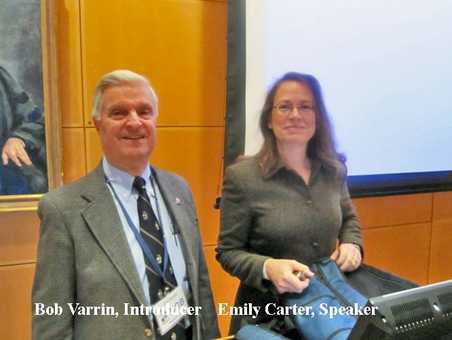November 13, 2013
Achieving a Sustainable Energy Future via
Quantum Mechanics and the Andlinger Center
Emily Carter
Director, Princeton’s Andlinger Center for
Energy and the Environment
Achieving a Sustainable Energy Future via
Quantum Mechanics and the Andlinger Center
Emily Carter
Director, Princeton’s Andlinger Center for
Energy and the Environment
Minutes of the Tenth Meeting of the 72nd Year
The 10th meeting of the 72nd year of the Old Guard of Princeton was called to order by Ruth Miller, President. Attendance was 109.
Julia Coale led the invocation.
The minutes of the Nov 6th meeting were read by Nick Wilson.
Two new members were introduced: Alan Dybvig and David Fulmer.
Diana Crane introduced a guest: her husband, Giles Crane.
Bob Varrin introduced our speaker, Emily A. Carter, who is the Founding Director of The Andlinger Center for Energy and the Environment.
The title of her talk was: “Achieving a Sustainable Energy Future Via Quantum Mechanics and the Andlinger Center.”
First, about the Andlinger Center: It is a multidisciplinary program to translate fundamental knowledge into practical ways of producing energy sustainably, conserving that energy, and protecting the Earth’s environment and climate from change caused by humans. The Andlinger Center is the building under construction on the corner of Olden Street and Prospect Avenue.
The problem, as stated by Professor Carter, is dire: 82% of the energy that we now use in the U.S. “comes from non-renewable fossil fuels that warm the Earth, cause climate change, distort international relations, and threaten the global economy.”
Saving the planet is her goal. Pessimism was not in her vocabulary as she described technological efforts to help move the planet onto a sustainable energy path.
Right now, we can see buildings, industry, and vehicles becoming increasingly energy efficient. Hydro-fracking is producing cheap natural gas, which is replacing need for coal. Electric vehicles are reducing need for oil imports.
Looking forward, goals include cheap solar and wind power, safer nuclear power, cheap durable fuel cells, recovery of waste heat, capture and sequestration of carbon dioxide, development of biofuels from algae, biomass, or bacteria.
Further into the future, Carter sees development of solar fuels, grid scale storage, and safe fusion power.
Professor Carter’s current research is focused entirely on enabling discovery and design of molecules and materials for sustainable energy, including converting sunlight to electricity and fuels, providing clean electricity from solid oxide fuel cells, achieving clean and efficient combustion of biofuels, optimizing lightweight metal alloys for fuel-efficient vehicles, and characterizing hydrogen isotope incorporation into plasma facing components of fusion reactors.
The theory behind her research is quantum mechanics, which, in her words, “accounts for the fundamental physics governing the energy and spatial distributions of electrons in matter.” She develops “mathematical and physical approximations to the Schrödinger wave equation, whose eigenvalues and eigenfunctions delineate the distribution of electrons in energy and space, respectively. . . ” She continues: “These powerful methods can be used to study systems that aim to render sustainable energy a reality: from biodiesel fuel combustion to solar energy conversion to electricity and fuels to fuel cells to fusion reactors.”
Respectfully submitted,
Sarah Hollister
Julia Coale led the invocation.
The minutes of the Nov 6th meeting were read by Nick Wilson.
Two new members were introduced: Alan Dybvig and David Fulmer.
Diana Crane introduced a guest: her husband, Giles Crane.
Bob Varrin introduced our speaker, Emily A. Carter, who is the Founding Director of The Andlinger Center for Energy and the Environment.
The title of her talk was: “Achieving a Sustainable Energy Future Via Quantum Mechanics and the Andlinger Center.”
First, about the Andlinger Center: It is a multidisciplinary program to translate fundamental knowledge into practical ways of producing energy sustainably, conserving that energy, and protecting the Earth’s environment and climate from change caused by humans. The Andlinger Center is the building under construction on the corner of Olden Street and Prospect Avenue.
The problem, as stated by Professor Carter, is dire: 82% of the energy that we now use in the U.S. “comes from non-renewable fossil fuels that warm the Earth, cause climate change, distort international relations, and threaten the global economy.”
Saving the planet is her goal. Pessimism was not in her vocabulary as she described technological efforts to help move the planet onto a sustainable energy path.
Right now, we can see buildings, industry, and vehicles becoming increasingly energy efficient. Hydro-fracking is producing cheap natural gas, which is replacing need for coal. Electric vehicles are reducing need for oil imports.
Looking forward, goals include cheap solar and wind power, safer nuclear power, cheap durable fuel cells, recovery of waste heat, capture and sequestration of carbon dioxide, development of biofuels from algae, biomass, or bacteria.
Further into the future, Carter sees development of solar fuels, grid scale storage, and safe fusion power.
Professor Carter’s current research is focused entirely on enabling discovery and design of molecules and materials for sustainable energy, including converting sunlight to electricity and fuels, providing clean electricity from solid oxide fuel cells, achieving clean and efficient combustion of biofuels, optimizing lightweight metal alloys for fuel-efficient vehicles, and characterizing hydrogen isotope incorporation into plasma facing components of fusion reactors.
The theory behind her research is quantum mechanics, which, in her words, “accounts for the fundamental physics governing the energy and spatial distributions of electrons in matter.” She develops “mathematical and physical approximations to the Schrödinger wave equation, whose eigenvalues and eigenfunctions delineate the distribution of electrons in energy and space, respectively. . . ” She continues: “These powerful methods can be used to study systems that aim to render sustainable energy a reality: from biodiesel fuel combustion to solar energy conversion to electricity and fuels to fuel cells to fusion reactors.”
Respectfully submitted,
Sarah Hollister

